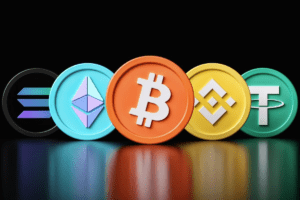Compreender Solana
Para compreender o conceito de Solana, é essencial começar por apresentar o que é Solana e compreender as noções básicas da tecnologia de cadeia de blocos.
Introdução a Solana
Solana é uma cadeia de blocos de alto desempenho plataforma O sistema de computação em nuvem da Microsoft foi projetado para enfrentar os desafios de escalabilidade enfrentados pelas redes de blockchain existentes. O seu objetivo é fornecer uma infraestrutura rápida, segura e descentralizada para o desenvolvimento de aplicações descentralizadas (dApps) e a execução de contratos inteligentes.
A Solana diferencia-se pela utilização de uma combinação única de tecnologias e princípios de design arquitetónico para alcançar uma escalabilidade sem precedentes sem comprometer a descentralização. A sua abordagem inovadora atraiu uma atenção significativa na indústria de blockchain.
Para aprofundar os meandros de Solana, é importante ter uma compreensão fundamental da tecnologia blockchain.
Noções básicas sobre a tecnologia Blockchain
A tecnologia Blockchain é um sistema de registo descentralizado e distribuído que permite o registo seguro e transparente de transacções em vários computadores ou nós. Serve como a tecnologia subjacente a várias criptomoedas e plataformas, incluindo Solana.
No seu núcleo, uma cadeia de blocos é constituída por uma cadeia de blocos, em que cada bloco contém uma lista de transacções verificadas. Estas transacções são agrupadas e ligadas criptograficamente ao bloco anterior, formando uma cadeia de blocos. Esta imutabilidade garante a integridade e a segurança dos dados armazenados na cadeia de blocos.
As principais características da tecnologia blockchain incluem descentralização, transparência, imutabilidade e segurança. Ao descentralizar o controlo e ao basear-se em mecanismos de consenso, como a prova de trabalho (PoW) ou a prova de participação (PoS), as redes de cadeia de blocos eliminam a necessidade de intermediários e proporcionam um ambiente sem confiança para as transacções.
Solana aproveita o poder da tecnologia blockchain enquanto introduz abordagens inovadoras à escalabilidade. A compreensão desses conceitos estabelecerá as bases para explorar as soluções exclusivas de Solana para o desafio da escalabilidade. Para mais informações sobre a tokenomics, o ecossistema e outros aspectos de Solana, visite o nosso artigo sobre Solana.
O desafio da escalabilidade
No mundo da tecnologia de cadeia de blocos, a escalabilidade é um fator crucial para o sucesso e a adoção generalizada de qualquer plataforma de cadeia de blocos. A escalabilidade refere-se à capacidade de uma rede de cadeia de blocos para lidar com um grande número de transacções de forma eficiente e atempada. Solana, uma plataforma de cadeia de blocos de alto desempenho, tem como objetivo resolver o desafio da escalabilidade que muitas cadeias de blocos existentes enfrentam.
A importância da escalabilidade na cadeia de blocos
A escalabilidade desempenha um papel vital na funcionalidade geral e na usabilidade de uma rede blockchain. À medida que o número de utilizadores e de transacções numa cadeia de blocos aumenta, torna-se essencial que a rede consiga lidar com a carga sem comprometer o seu desempenho. Sem escalabilidade, as cadeias de blocos podem registar estrangulamentos, velocidades de transação mais lentas e custos de transação mais elevados, dificultando a sua capacidade de utilização em aplicações do mundo real.
A escalabilidade é particularmente crucial em indústrias que requerem elevados volumes de transacções, tais como finanças, gestão da cadeia de fornecimento e aplicações descentralizadas (dApps). Ao fornecer uma solução escalável, as cadeias de blocos podem desbloquear o potencial para uma adoção generalizada e impulsionar a inovação em vários sectores.
Problemas comuns de escalabilidade nas cadeias de blocos existentes
Muitas das cadeias de blocos existentes enfrentam desafios no que respeita à escalabilidade. Alguns dos problemas comuns de escalabilidade incluem:
-
Velocidades de transação limitadas: As cadeias de blocos tradicionais, como Bitcoin e Ethereum têm velocidades de transação limitadas devido aos seus mecanismos de consenso e às limitações de dimensão dos blocos. Isto pode resultar em tempos de confirmação mais lentos e congestionamento durante os períodos de pico de utilização.
-
Elevados custos de transação: À medida que a procura de transacções aumenta, aumenta também o custo do processamento dessas transacções. Em redes com escalabilidade limitada, os utilizadores podem ter de pagar taxas elevadas para que as suas transacções sejam processadas rapidamente.
-
Baixo rendimento: A taxa de transferência refere-se ao número de transacções que uma cadeia de blocos pode processar por segundo. Muitas cadeias de blocos debatem-se com um baixo rendimento, o que pode causar atrasos nas confirmações de transacções e limitar a sua capacidade de lidar com um grande volume de transacções em simultâneo.
-
Compensações de escalabilidade: Algumas cadeias de blocos tentam melhorar a escalabilidade sacrificando a descentralização ou a segurança. Estas soluções de compromisso podem comprometer a integridade e a fiabilidade da rede.
Solana aborda estes desafios de escalabilidade através da implementação de soluções inovadoras e da adoção de uma abordagem única para a construção de uma plataforma de blockchain de elevado desempenho. Ao tirar partido da sua arquitetura e das suas principais características, Solana visa proporcionar velocidades de transação rápidas, custos de transação reduzidos e um elevado rendimento. Na próxima secção, exploraremos mais detalhadamente as soluções de escalabilidade oferecidas por Solana.
Soluções de escalabilidade da Solana
À medida que a tecnologia blockchain continua a ganhar impulso, a escalabilidade tornou-se um fator crítico na sua adoção generalizada. Solana, uma plataforma de blockchain de alto desempenho, oferece soluções exclusivas para enfrentar os desafios de escalabilidade enfrentados pelas blockchains existentes. Vamos explorar a abordagem de Solana à escalabilidade e os principais recursos que a permitem.
Abordagem única da Solana para escalabilidade
Solana adopta uma abordagem revolucionária à escalabilidade, combinando várias técnicas inovadoras. Um de seus principais diferenciais é a introdução de um algoritmo de consenso inovador chamado Proof of History (PoH). O PoH fornece um registo histórico de todos os eventos na rede Solana, permitindo uma ordenação eficiente e segura das transacções. Isso elimina a necessidade de mecanismos de consenso que consomem muitos recursos, como Proof of Work (PoW) ou Proof of Stake (PoS). Ao aproveitar o PoH, Solana atinge velocidades e escalabilidade sem precedentes, sem comprometer a segurança.
Outro aspeto crítico da abordagem de escalabilidade do Solana é o uso de um mecanismo exclusivo chamado Tower BFT (Byzantine Fault Tolerance). O Tower BFT melhora a tolerância a falhas da rede ao utilizar técnicas criptográficas para validar e confirmar transacções. Este mecanismo de consenso permite a Solana alcançar uma finalidade rápida, garantindo que as transacções confirmadas são irreversíveis e seguras.
Principais características que permitem a escalabilidade
Solana incorpora várias características chave que contribuem para as suas impressionantes capacidades de escalabilidade:
-
Processamento paralelo: O Solana utiliza uma técnica conhecida como processamento paralelo, que permite o processamento simultâneo de várias transacções. Ao dividir as tarefas em unidades menores e executá-las em paralelo, Solana aumenta significativamente o rendimento da rede.
-
Estado globalmente partilhado: Solana mantém um estado único e globalmente partilhado em toda a sua rede. Esse estado compartilhado garante que todos os nós tenham acesso às mesmas informações, eliminando a necessidade de protocolos complexos de sincronização de dados. Como resultado, Solana alcança alta consistência e reduz a latência, permitindo confirmações de transação mais rápidas.
-
Estrutura de dados optimizada: Solana utiliza uma estrutura de dados única chamada Tower Ledger. Esta estrutura de dados optimizada facilita o armazenamento e a recuperação eficientes dos dados de transação, melhorando ainda mais o desempenho e a escalabilidade da rede.
-
Prova de replicação: Solana incorpora um mecanismo chamado Proof of Replication (PoRep) para garantir a integridade dos dados. O PoRep verifica se cada nó da rede possui uma cópia exclusiva dos dados do blockchain. Essa redundância garante a disponibilidade e a confiabilidade dos dados, contribuindo para a escalabilidade geral e a tolerância a falhas do Solana.
Ao combinar estas características, a Solana emergiu como uma plataforma de cadeia de blocos altamente escalável, capaz de lidar com milhares de transacções por segundo. O seu desempenho rivaliza com o dos sistemas financeiros tradicionais, tornando-a uma solução promissora para várias aplicações e indústrias.
À medida que a demanda por soluções de blockchain escalonáveis continua a crescer, a abordagem inovadora e os principais recursos da Solana a posicionam como pioneira no setor. Para saber mais sobre a tokenomics, o ecossistema e os planos futuros da Solana, confira nosso artigo sobre Solana tokenomics, ecossistema de solanae roteiro solana.
A Arquitetura Solana
Para compreender plenamente a escalabilidade do Solana, é importante aprofundar a sua arquitetura e as tecnologias subjacentes que permitem as suas capacidades de elevado desempenho. A arquitetura Solana é construída sobre o protocolo Solana e utiliza um algoritmo de consenso único.
O papel do Protocolo de Solana
No centro da arquitetura de Solana está o protocolo Solana. O protocolo serve de base para a rede de blockchain Solana, fornecendo as regras e directrizes necessárias para o seu funcionamento. Estabelece o enquadramento para a forma como as transacções são processadas, validadas e registadas na cadeia de blocos.
O protocolo Solana incorpora várias tecnologias e características inovadoras para atingir os seus objectivos de escalabilidade. Estas incluem uma combinação de Prova de Histórico (PoH), Prova de Participação (PoS) e outros mecanismos de consenso. Ao alavancar essas tecnologias, o Solana é capaz de alcançar alto rendimento e velocidades de transação rápidas, revolucionando a escalabilidade das redes blockchain.
Para obter mais informações sobre o protocolo Solana e as suas características únicas, pode consultar a Livro branco Solana.
O Algoritmo de Consenso Solana
O algoritmo de consenso do Solana, conhecido como Tower BFT (Byzantine Fault Tolerance), desempenha um papel vital na garantia da segurança e do consenso da rede Solana. O Tower BFT é uma variação do tradicional algoritmo Practical Byzantine Fault Tolerance (PBFT), adaptado especificamente para atender aos requisitos de escalabilidade do Solana.
A Tower BFT utiliza uma combinação de PoS e PoH para obter consenso. O PoH fornece uma ordem cronológica de eventos, permitindo que os validadores cheguem a acordo sobre a ordem exacta das transacções. Os validadores na rede Solana participam no processo de consenso apostando os seus tokens SOL e contribuindo com recursos computacionais para validar transacções e proteger a rede.
Com o seu algoritmo de consenso único, a Solana consegue uma rápida confirmação final e de baixa latência das transacções, permitindo um elevado rendimento e escalabilidade. A rede é capaz de lidar com milhares de transacções por segundo, o que a torna adequada para uma vasta gama de aplicações e casos de utilização.
Ao compreender o papel do protocolo Solana e do algoritmo de consenso Solana, torna-se claro como o Solana superou os desafios de escalabilidade enfrentados por muitas outras redes de blockchain. A sua arquitetura inovadora e a sua pilha de tecnologia permitem velocidades de transação rápidas, baixos custos de transação e um elevado rendimento, tornando-a uma solução promissora para o futuro da tecnologia de cadeia de blocos.
Na próxima secção, exploraremos as vantagens da escalabilidade de Solana e as suas implicações para a indústria da cadeia de blocos. Fique atento para saber mais sobre as potenciais aplicações e casos de uso de Solana e seu impacto no ecossistema de blockchain.
Vantagens da escalabilidade de Solana
A abordagem inovadora da Solana à escalabilidade na tecnologia blockchain traz várias vantagens que a diferenciam das soluções existentes. Estas vantagens incluem velocidades de transação rápidas, custos de transação reduzidos e um elevado rendimento.
Velocidades de transação rápidas
Uma das principais vantagens da escalabilidade de Solana é a sua capacidade de atingir velocidades de transação rápidas. A arquitetura e o design únicos do Solana permitem-lhe processar um elevado volume de transacções em paralelo. Ao utilizar uma combinação de estruturas de dados optimizadas e algoritmos avançados, Solana pode lidar com um grande número de transacções simultaneamente, resultando em tempos de transação significativamente reduzidos em comparação com outras cadeias de blocos.
As rápidas velocidades de transação oferecidas pelo Solana tornam-no ideal para aplicações que requerem um processamento de transacções quase em tempo real. Isto abre possibilidades para vários casos de utilização, tais como transacções de alta frequência comercialaplicações financeiras descentralizadas (DeFi) e trocas descentralizadas (DEXs). Para saber mais sobre o impacto de Solana na indústria de blockchain, confira nosso artigo sobre O impacto de Solana no sector da cadeia de blocos.
Baixos custos de transação
Outra vantagem da escalabilidade de Solana é a sua capacidade de manter baixos custos de transação. As redes tradicionais de blockchain enfrentam frequentemente problemas de escalabilidade que aumentam as taxas de transação devido ao congestionamento da rede. A arquitetura de Solana e o seu algoritmo de consenso eficiente permitem-lhe processar um grande número de transacções sem a necessidade de pagar taxas elevadas.
Os baixos custos de transação associados ao Solana tornam-no uma opção atractiva para empresas e programadores que procuram criar aplicações descentralizadas (dApps) ou lançar ofertas de tokens. Ao minimizar os custos de transação, o Solana permite uma participação mais acessível e acessível em atividades baseadas em blockchain.
Alto rendimento
As soluções de escalabilidade da Solana também permitem um elevado rendimento, o que significa que pode tratar um grande número de transacções por segundo. A capacidade de alto rendimento da rede Solana é o resultado da sua abordagem de processamento paralelo e da sua capacidade de validar transacções em simultâneo. Isso permite a utilização eficiente dos recursos da rede e garante que a rede possa lidar com o aumento da demanda sem sacrificar o desempenho.
A elevada taxa de transferência oferecida pelo Solana abre oportunidades para aplicações que requerem um processamento de transacções rápido e contínuo. Casos de uso como jogos, sistemas de identidade digital e gerenciamento da cadeia de suprimentos podem se beneficiar da capacidade do Solana de lidar com um alto volume de transações sem problemas.
As vantagens de Solana em termos de velocidades de transação rápidas, baixos custos de transação e elevado rendimento posicionam-na como uma solução promissora para enfrentar os desafios de escalabilidade enfrentados pelas redes de cadeias de blocos existentes. Estas vantagens fazem de Solana uma opção atractiva para programadores, empresas e utilizadores que procuram uma plataforma de blockchain de elevado desempenho.
O futuro de Solana
Como Solana continua a fazer ondas no espaço do blockchain com suas impressionantes soluções de escalabilidade, o futuro dessa tecnologia tem um imenso potencial. Vamos explorar algumas das aplicações potenciais e casos de uso de Solana, bem como seu impacto na indústria de blockchain como um todo.
Aplicações potenciais e casos de utilização
A escalabilidade e o elevado rendimento de Solana tornam-no adequado para uma vasta gama de aplicações em vários sectores. Aqui estão alguns casos de uso potencial para Solana:
-
Finanças descentralizadas (DeFi): As rápidas velocidades de transação e os baixos custos de transação da Solana fazem dela uma plataforma ideal para aplicações DeFi, tais como trocas descentralizadas, plataformas de empréstimo e empréstimo, stablecoins e muito mais. Sua escalabilidade garante que esses aplicativos possam lidar com um grande volume de transações sem congestionamento ou taxas altas.
-
Jogos de azar e fichas não fungíveis (NFT): A indústria de jogos tem visto um aumento no interesse pela tecnologia blockchain, e a escalabilidade de Solana pode fornecer uma experiência perfeita para os jogadores, permitindo transações rápidas e seguras no jogo. Além disso, o alto rendimento de Solana é benéfico para os mercados NFT, onde a capacidade de lidar com um grande volume de transações é crucial.
-
Gestão da cadeia de abastecimento: A escalabilidade de Solana pode melhorar a gestão da cadeia de abastecimento, garantindo transacções rápidas e transparentes. Com Solana, as empresas podem acompanhar e verificar o movimento de mercadorias ao longo da cadeia de abastecimento de uma forma segura e eficiente, reduzindo a fraude e melhorando a transparência global.
-
Aplicações descentralizadas (dApps): A escalabilidade do Solana permite o desenvolvimento de dApps complexos e de alto desempenho. De plataformas de mídia social a soluções de armazenamento descentralizadas, as velocidades rápidas de transação e os baixos custos de Solana fornecem uma base sólida para a criação de aplicativos inovadores que podem lidar com uma grande base de usuários.
O impacto de Solana na indústria da cadeia de blocos
A abordagem única de Solana para escalabilidade tem o potencial de revolucionar a indústria de blockchain de várias maneiras:
-
Melhoria da experiência do utilizador: As rápidas velocidades de transação e os baixos custos da Solana melhoram a experiência geral do utilizador, tornando a tecnologia blockchain mais acessível a um público mais vasto. Isto pode impulsionar a adoção generalizada e abrir novas oportunidades de inovação.
-
Aumento da eficiência: O elevado rendimento e a escalabilidade de Solana reduzem o congestionamento e os estrangulamentos registados pelas cadeias de blocos existentes. Esta maior eficiência permite transacções mais rápidas e mais rentáveis, beneficiando tanto as empresas como os utilizadores.
-
Incentivar a inovação: As soluções de escalabilidade da Solana fornecem aos desenvolvedores uma plataforma poderosa para criar aplicativos novos e inovadores. A capacidade de lidar com um grande número de transações em tempo real pode abrir novas possibilidades e impulsionar a criação de soluções descentralizadas inovadoras.
-
Crescimento do ecossistema: À medida que Solana continua a ganhar força, o seu ecossistema está a expandir-se rapidamente. Esse crescimento inclui parcerias com outros projetos de blockchain, colaborações com líderes do setor e o desenvolvimento de uma comunidade vibrante. O ecossistema em expansão contribui para a força geral e a sustentabilidade de Solana.
Com sua escalabilidade impressionante e aplicações potenciais, Solana está pronta para moldar o futuro da indústria de blockchain. À medida que os programadores continuam a explorar as suas capacidades e as empresas aproveitam as suas vantagens, o Solana tem o potencial de conduzir a uma adoção generalizada e transformar a forma como interagimos com as tecnologias descentralizadas.



